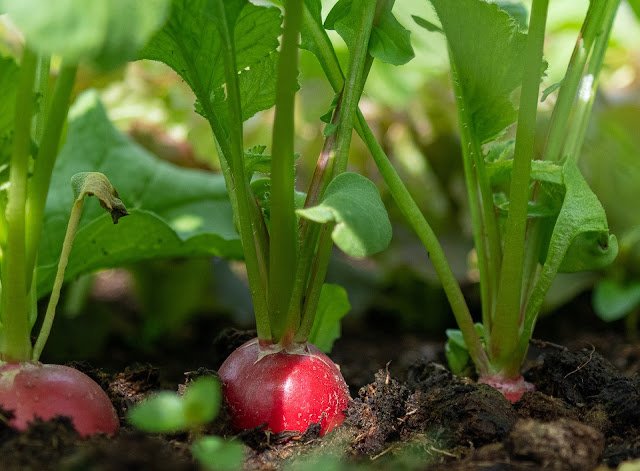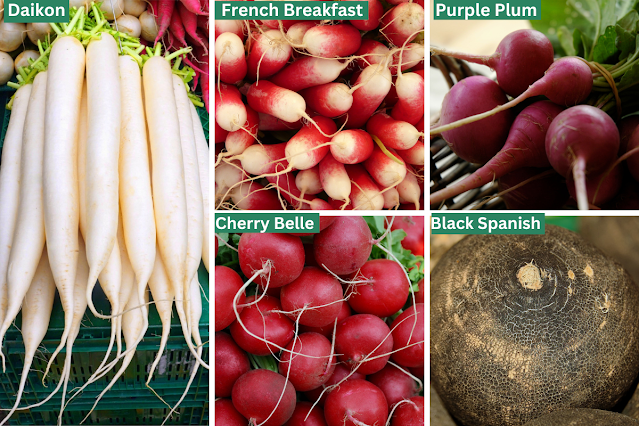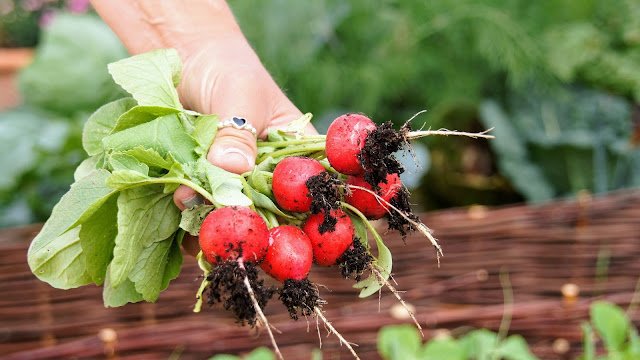The Best Fluffy Pancakes recipe you will fall in love with. Full of tips and tricks to help you make the best pancakes.
Growing Radishes: How to Plant, Care For, and Harvest

Table of Contents
Radishes (Raphanus sativus) are an easy and rewarding first step into growing your own food. Growing radishes is an easy and satisfying way to get into gardening. These crunchy, peppery root vegetables mature quickly, require little fuss and are a great choice for cool-season gardeners. If you have a backyard garden, a small patch of land, or simply a sunny container in your balcony, radishes are more than appropriate for your space. They are also a great companion plant They’re also great companion plants, helping deter pests from veggies like cucumbers, lettuce, and spinach, making your whole garden healthier overall.
In this ultimate radish growing guide, we’ll go through everything from how to plant, care for, and harvest at the peak of flavor. With this guide, you’ll grow the best tasting, crisp radishes, right in your garden.
| Common Name | Radish |
|---|---|
| Scientific Name | Raphanus sativus |
| Family | Brassicaceae |
| Plant Type | Root vegetable |
| Growth Speed | Fast-growing (3-8 weeks) |
| Preferred Climate | Cool season (early spring, fall) |
| Soil Preparation | Loosen soil 8-10 inches deep; compost added |
| pH Level | 6.0 – 7.0 |
| Harvest Size | 1 inch diameter or variety-specific size |
| Harvest Timing | Spring radishes: 3-4 weeks; Winter radishes: 6-8 weeks |
| Edible Parts | Roots, greens |
Growing Radishes: Choosing the Right Variety
Selecting the type of radish for your garden and taste buds is the first step in planting them. There are many varieties of radish with their own distinctive flavors, colors and growing times. Some varieties grow quickly, making them perfect for fresh salads, while others take longer, with potent flavor that’s great for cooking or pickling.
- Spring Radishes: Varieties such as ‘Cherry Belle’ and ‘French Breakfast’ are favorites because they ripen quickly — typically in 3 to 4 weeks. These radishes are small, round and mild in flavor, making them great in salads, sandwiches or for eating fresh.
- Winter Radishes: Almeida says varieties including ‘Daikon’ or ‘Black Spanish’ can be grown larger and take 6 to 8 weeks to mature. These radishes work great in stir-fries, soups and in pickling. They have a more subtle flavor than spring radishes, and are great for those who like hardier root vegetables.
- Specialty Types: If you want to inject some color, add watermelon or purple plum radishes to your garden and dinner table. These kinds contribute a balance of sweet-spicy flavors, plus beautiful shades of pink, purple or white. They’re also fun to grow for their visual impact, so are a great choice for novice gardeners wanting to try out different radish varieties.

Best Time and Techniques for Growing Radishes
When to Plant Radishes
Radishes are cool-weather crops, so they do best in mild weather. Planting radishes at the right time goes according to your local climate. What are the general rules? Here are a few:
- Spring: Sow radishes 4 to 6 weeks before your last spring frost. In cooler climates, this will allow you to get a fresh crop in before the summer heat arrives.
- Fall: For a fall harvest, plant radish seeds 8 to 10 weeks before the first anticipated frost. Fall radishes are usually milder and more flavorful because of their growing season in cooler weather.
Radishes, unlike other brassicas, cannot be grown in the heat of summer, which causes them to bolt (go to seed) quickly, ruining the crop and making the roots taste bitter.
Best Soil for Radishes
Radishes do best in soft, rich, well-drained ground. This will make sure the roots develop in a straight way and healthy. Loosen the soil 8–10 inches down by digging, incorporating compost to improve its texture and nutrient content.
- Don’t use overly rich soil: Too much nitrogen in fertilizer leads to big leafy tops and tiny roots, so make sure you’re using balanced soil.
- pH: Ideally, the pH should be 6.0 — 7.0. You can test the soil using a basic pH meter to check that it stays within that range.
What is the Right Way to Plant Your Radish Seeds
Planting radish seeds is straightforward. Here’s how to ensure your radishes have the best start:
- Planting Depth: Seeds should be sown approximately 1/2 inch deep in the soil. They should be spaced 1 inch apart in rows 12 inches apart.
- Thinning: When the seedlings have sprouted, thin them to a spacing of 2–3 inches apart. Thinning is necessary to avoid overcrowding, so that each radish root has adequate space in which to grow.
You’ll be encouraging even growth by spacing and planting at the right depth, which will yield healthy, crisp radishes.
Radish Plant Care: Water, Light, and Fertilizer Tips
They are very easy to grow little things, but there are a few important things to know to make sure they thrive.
- Sunlight: Grow radishes in full sun, though they can handle partial shade, especially when the weather is warm. Adequate sunlight is essential for root development and growing carrots in too little sunlight can often lead to smaller, spicy or misshaped roots.
- Water: Left thirsty, radishes become tough; proper moisture is the secret to success. Water one inch per week is the goal. Do not overwater, which can cause damp-off, or underwater, which can produce woody, bitter radishes. Get mulch to put around the plants to help retain moisture in the soil and keep weeds from competing for nutrients.
- Fertilizer: Radishes grow quickly but don’t need to be heavily fed. Incorporate compost into the soil at planting time and/or use a balanced, low-nitrogen fertilizer. Steer clear of high-nitrogen fertilizers; this encourages leaf growth but starves root development.
Growing Radishes in Containers
Not everyone has a lot of garden space, but fortunately, radishes will grow in containers. Here’s how to plant radishes in containers and tight spots:
- Container Size: Opt for pots that are no less than 6–8 inches in depth, and make sure they have drainage holes to avoid waterlogging.
- Soil: Use a light, well-draining potting mix, and fill the containers. Do not use heavyweight garden soil, as they can compact in containers and restrict root growth.
- Planting: Sow the seeds 1/2 inch deep and 2–3 inches apart. Radishes require room to grow, so provide plenty of space for them.
Detecting Radish Pests and Illness: What to Avoid
Radishes are fairly resilient, but there are a few pests and diseases to keep an eye out for:
Common Pests
- Flea Beetles: These little critters eat holes in the tissues. Protect them with row covers, or spray with insecticidal soap.
- Root Maggots: Root maggots burrow into the roots, destroying your crop. Crop rotation can help keep these pests from overwintering.
Diseases
- Downy Mildew: This fungal disease flourishes in wet, poorly ventilated spaces. To avoid it, don’t water from above and make sure the plants have good air circulation between them.
- Root Rot: Similar to downy mildew, root rot is prevalent in poorly-drained soil. Make Top Notch, Well-Draining Soil and Don’t Over Water.
Harvesting Radishes at the Right Time

How Long Do Radishes Take To Grow?
- Spring Radishes: Ready in around 3–4 weeks.
- Winter Radishes: These do take a little longer, about 6–8 weeks.
When to Harvest Radishes
Be sure to check your radishes often as they approach maturity. Collect them when they are approximately 1 inch in diameter. Wait too long and they become woody and bitter.
How to Harvest
For harvesting, pull the radishes out of the soil with care. Take care to avoid damaging the roots. After harvest, trim the greens, which can rob moisture from the roots.
Storing Radishes
To keep radishes, cut off the greens and store the roots in the fridge. Spring radishes are good for a week or so, and winter types such as Daikon will keep in a cool place for up to a month.
FAQs
How often should I water radishes?
Consistent moisture is key when growing radishes. Water once or twice a week, applying about 1 inch of water each time. This keeps the soil evenly moist and helps prevent issues like split roots or tough texture.
Do radishes need full sun, or can they grow in shade?
Radishes prefer full sun for best growth, but they can tolerate partial shade—especially in hot summer climates. However, growing radishes in too much shade may result in smaller roots and milder flavor.
Why are my radishes only growing leaves and not roots?
If your radishes are all leaves and no roots, the soil may have too much nitrogen. Avoid high-nitrogen fertilizers and aim for a balanced nutrient mix to encourage proper root development.
When is the best time to plant radishes?
The best time for growing radishes is during early spring or late summer, when temperatures are cooler. Radishes thrive in cool weather and are less likely to bolt, giving you crisp, flavorful roots.
